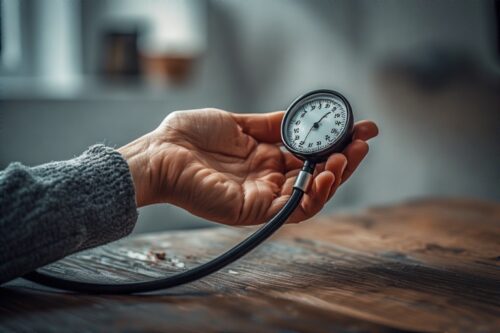
How to Reduce Systolic Blood Pressure: 7 Proven Life Changes That Worked for Me
I still remember the exact moment I realized I was in trouble.
It was a Tuesday morning. I had barely finished my coffee when I saw the reading on my home blood pressure monitor: 160 / 92.
I stared at the numbers like they were in a foreign language.
“160? That can’t be right. This thing’s broken.”
So, like any logical person… I took it again.
160. Again.
That laugh that escaped me wasn’t the kind you hear at a comedy show. It was the nervous, dry-throat kind that says: Oh crap… is this how it starts?
I’d heard all the horror stories about high blood pressure. My uncle’s stroke at 54. My mom’s daily pill routine. But I’d never put myself in that category. I was young-ish, still walking up stairs without getting winded (most of the time), and not what I’d call “unhealthy.”
But that morning, looking at those numbers, I realized my body had been sending me warning signs for months… and I’d been ignoring every single one.
Phase 1: The Wake-Up Call
Here’s the thing about high systolic blood pressure: it doesn’t punch you in the face.
It creeps in like an unwanted roommate who slowly takes over your fridge.
For me, the signs were subtle:
-
The random headaches I blamed on “too much screen time.”
-
The occasional dizziness I blamed on “standing up too fast.”
-
That constant tight feeling in my neck that I thought was “just stress.”
I brushed it all off. Because facing the truth meant doing something about it — and honestly, I wasn’t ready.
But that morning reading? That was my line in the sand.
Phase 2: The Trial-and-Error Disaster
I wish I could tell you I handled this like a mature, rational adult.
Instead… I went straight to Google.
Bad idea.
Within 15 minutes, I’d convinced myself I needed to:
-
Drink beet juice every morning.
-
Give up salt entirely (even in bread).
-
Start meditating for an hour a day.
-
Take three different “blood pressure support” supplements.
I tried all of it. For a while, my kitchen looked like a cross between a juice bar and an herbal apothecary.
Some of it made me feel a little better. Some of it did absolutely nothing. And a couple of things actually made my readings worse — looking at you, high-caffeine “energy green tea” I thought was healthy.
Two months in, my readings were slightly better… but still in the danger zone. I was frustrated, bloated from too much beet juice, and tired of peeing every hour.
That’s when I stopped chasing random tips and started actually listening to my body.
Phase 3: The 7 Proven Life Changes That Actually Worked
Here’s what finally moved the needle — the stuff that took my systolic readings from 160 down to an average of 122–128 over about five months.
1. Tracking My Mornings Without Obsessing
I used to check my blood pressure three times a day, which just stressed me out more. Now? I check it once in the morning before coffee or breakfast.
It’s enough to see trends without spiraling into panic over one bad reading.
Over time, this taught me what actually affected my numbers — and what didn’t.
2. Fixing My Salt Habits Without Giving Up Flavor
At first, I tried cutting out salt completely. Big mistake. Food tasted like cardboard, and I started craving junk just to get some flavor.
Instead, I switched to using:
-
Herbs and spices (garlic powder, smoked paprika, oregano).
-
Lemon juice for brightness.
-
Low-sodium salt blends for that “salty hit” without the overload.
I also started checking labels — you’d be shocked how much sodium is in bread, soup, and even “healthy” wraps.
3. Walking 20 Minutes After Dinner
This one shocked me.
I started doing a slow 20-minute walk after dinner, not for exercise but to help digestion. Within weeks, my morning readings dropped a few points.
Turns out, it also helped my sleep (which helped my stress… which helped my BP).
It’s the simplest change, but it’s become non-negotiable.
4. Swapping Coffee Overload for Herbal Tea Rotations
I love coffee. But coffee doesn’t always love me back.
I didn’t quit cold turkey (that would’ve been ugly). I cut my cups from 3–4 a day to 1 in the morning, then switched to hibiscus tea or chamomile later.
Fun fact: hibiscus tea actually has a mild blood-pressure-lowering effect. Also, it’s a deep ruby red, so it feels fancy.
5. Learning to “Downshift” Stress in 90 Seconds
One thing I learned? My blood pressure spiked fast during stress — even small stuff like traffic or emails.
So I started using a 90-second “reset”:
-
Inhale through my nose for 4 seconds.
-
Hold for 4.
-
Exhale slowly for 6.
-
Repeat until I feel my shoulders drop.
It sounds silly, but this mini-break has stopped more BP spikes than any supplement I’ve tried.
6. Sleeping Like My Life Depended on It
Because it kind of did.
When I started going to bed at the same time every night (and actually resting instead of scrolling TikTok until 1 a.m.), my numbers started leveling out.
I also invested in blackout curtains — game changer.
7. Making Small but Powerful Food Swaps
I didn’t overhaul my diet overnight. I just made little swaps:
-
White bread → whole grain.
-
Sugary cereal → oatmeal with berries.
-
Fried chicken → baked with olive oil and spices.
-
Soda → sparkling water with lime.
Nothing extreme, but over time, those small swaps added up.
What I Wish I Knew Earlier
-
The first 2 weeks are brutal — your body fights change.
-
Stress management is as important as diet.
Oh, and that “healthy” energy green tea I drank? Turns out it had more caffeine than coffee. No wonder my numbers spiked.
Reader Q&A – The Stuff People Always Ask Me
Q: How long until you saw results?
About 4–6 weeks before I saw consistent improvement. Full change took months.
Q: Did you do it without medication?
Yes, but I stayed in close touch with my doctor. If my numbers hadn’t improved, I’d have considered meds.
Q: What’s the biggest mistake to avoid?
Going all-in overnight. Start with one or two changes, get consistent, then add more.
I’m not saying my way is the way. But it’s the first time in my life I feel like I’m steering my health instead of waiting for a crisis.
If you’re staring at your own scary numbers right now… I get it. It’s overwhelming. But it’s not hopeless.
You can make small, real changes today — and your future self will thank you for every single one.
Was this helpful?
Please share your feedback to help us improve



